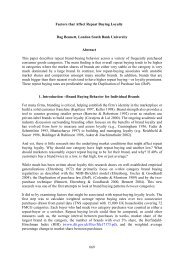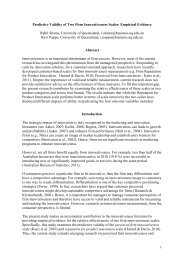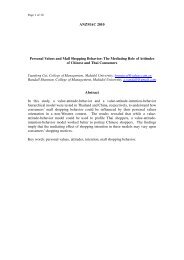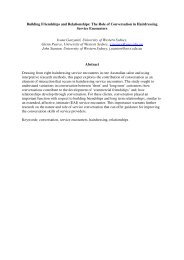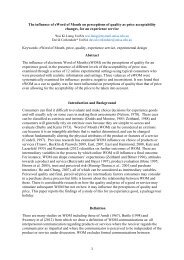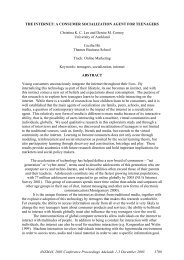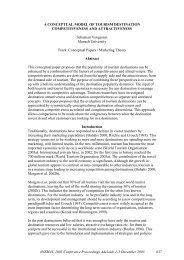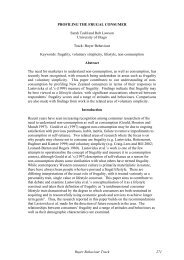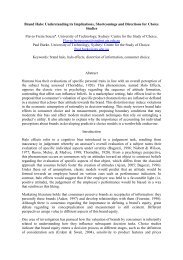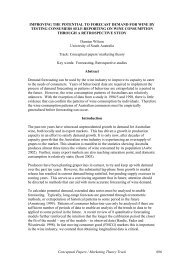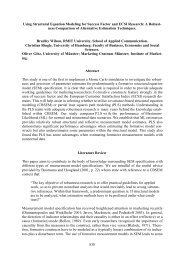Full Paper - ANZMAC
Full Paper - ANZMAC
Full Paper - ANZMAC
Create successful ePaper yourself
Turn your PDF publications into a flip-book with our unique Google optimized e-Paper software.
structure of complexity have been outlined (Güthoff 1995). The effects of<br />
complexity on service quality and customer satisfaction have been investigated<br />
only selectively: e.g. number of bundle elements (Danahar and Mattsson 1998)<br />
and duration of services (Czepiel et al. 1985, Danahar and Mattsson 1994, 1998;<br />
Geva und Goldman 1989) whereas criteria such as “multiple individuals<br />
involved”, “heterogeneity of bundle elements”, and “degree of individuality of the<br />
product” are still open for research.<br />
For marketing purposes it is essential to know what elements in a product and<br />
service bundle play a key role in the customer’s decision-making process.<br />
Bundling strategies in a competitive environment – first systematically outlined<br />
by Guiltinan (1987) – have their focus on product development and finding<br />
optimal prices. Similar problems in the tourism and hospitality context have been<br />
discussed by Kinberg and Sudit (1979), Green and Wind (1984), Sheldon and<br />
Mak (1987), and Bojanic and Calantone (1990). Nevertheless, their research<br />
approach is limited predominantly to the financial evaluation of quite a few<br />
product attributes and does not incorporate the instrumental role of those<br />
attributes in creating value and satisfaction to the customer.<br />
Therefore, it is essential to identify the various roles customers may play in the<br />
production process. Bitner et al. (1997) distinguish between three different roles:<br />
the customer as productive resource, the customer as contributor to quality,<br />
satisfaction and value, and the customer as competitor to the service organisation.<br />
According to these roles, different abstract levels of customer participation may<br />
occur: low level: only customer presence required (e.g. airline travel, fast-food<br />
restaurant), moderate level: customer inputs required (e.g. hair cut, advertising<br />
campaign), high level: customer co-creates service products (e.g. weightreduction<br />
programme, management seminar). Related issues have been raised<br />
addressing organisational socialisation by Bowen and Schneider (1985), Kelley et<br />
al. (1992), Lusch, Brown and Brunswick (1992) or the intrinsic attraction of selfservice<br />
by Bateson (1983, 1985) and Dabholkar (1996) or the relationship<br />
between satisfaction and failure attribution by Bitner (1990), Folkes (1988) and<br />
Hubbert (1995).<br />
If we take the experiential nature of services seriously (Lovelock 1979) we cannot<br />
separate the service’s personnel and environment from the consumer (Bateson<br />
1979). The situation in which the service consumption takes place involves<br />
several dimensions. Kotler (1973) addressed the physical setting by<br />
“atmospherics” including all perceptions of the five human senses. When Grove<br />
and Fisk (1983) discussed the dramaturgical perspective of service exchange<br />
processes both, the physical and social settings were integrated. Bagozzi (1975)<br />
emphasised the idea of symbolic exchange which is not limited to the core<br />
elements of products and services but extends to the physical environment as well<br />
as to the social interaction. Bitner (1992) proposed three dimensions of the socalled<br />
“servicescapes”: ambiente condition, spatial layout and functionality, and<br />
2887



